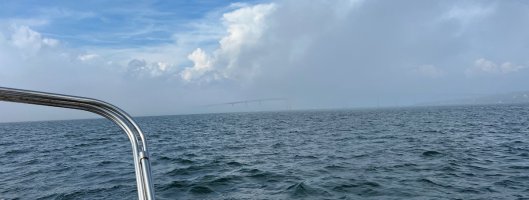Prairie Schooner
Jeff & Donna, E35-3 purchased 7/21

We have an old radar unit that came with the boat. It’s a monochrome screen, Furuno, which cannot be laced into our new B&G electronics package, 9” plotter at the helm, AIS transponder. In years past we’ve been out in fog on friends’ boats with no radar. We got through it, tooting horns, under sail so we could hear traffic. Our thoughts have been that it was nice to have, but not essential.
Earlier this week we were out for a day sail and had a fog bank roll in. This was our first fog experience with Kismet. It closed in a good deal more than pictured above so we had under 100 hundred yards visibility. We encountered some smaller sail and power boats, none of which were showing AIS. One 34’ picnic boat passed us much closer than I liked. (Confession: I hadn’t yet reconnected the old radar since restepping the mast.) We decided the day was no longer fun and with the chart plotter and local knowledge got back to our mooring without incident. In this case we had the ready option of a safe harbor.
This experience has got us thinking about getting new radar that can be integrated with our electronics. Our earlier experiences were ten years or more ago. Maybe I’ve grown more cautious with age. Maybe when you’re the one in ‘command’ the weight of responsibility is heavier. I feel less cavalier about it than I did back then.
If we’re halfway between Block Island and America (pt to pt about 22 miles) and fog moves in we’d really be on our toes. Our first option is to hook up the old kit and have someone below calling out targets when in the soup. This would require coordinating the old WW2 screen to a chartplotter mirrored on a tablet. Or we could buy new radar from which data can be laid on the helm chart plotter. When we’re double handing this would allow one person to be lookout and make noise.
- How vital do you think a modern radar system is?
- Have you been in low visibility and the radar didn’t give you as much or as reliable information as you’d have liked?
- What factors should we keep in mind if shopping for new radar?
We’re going to the Newport Boat Show tomorrow and will be talking to vendors.
Thanks much,
Jeff
Threads I found somewhat helpful
- https://ericsonyachts.org/ie/threads/ais-vhf-plotter-question.20130/page-2
- https://ericsonyachts.org/ie/threads/radome-installation-at-backstay.19282/#post-149778
Last edited:


